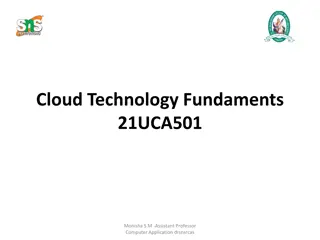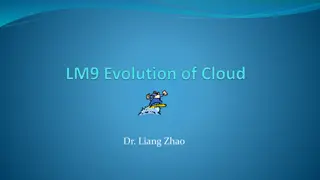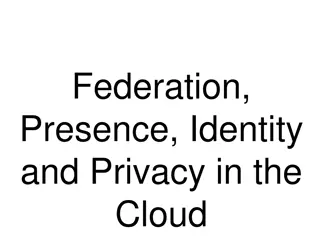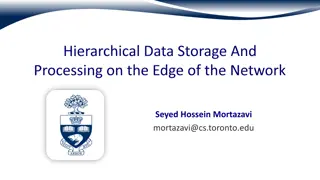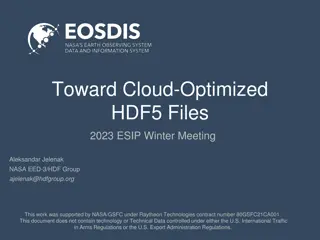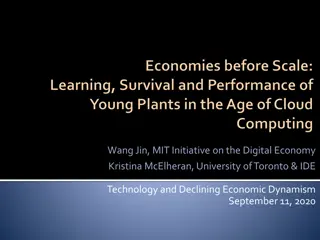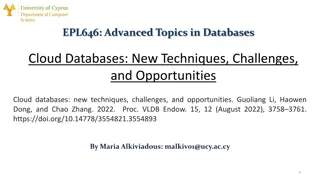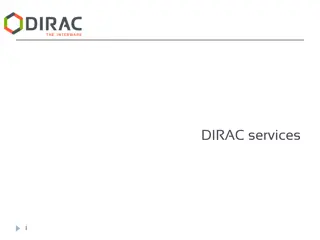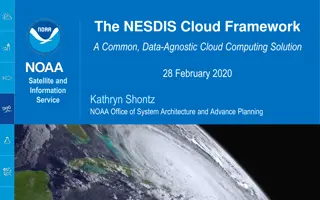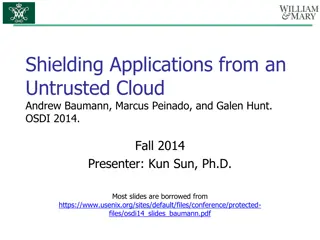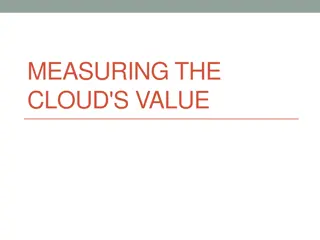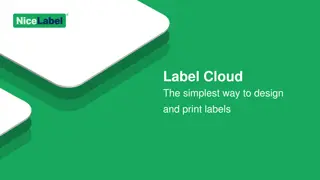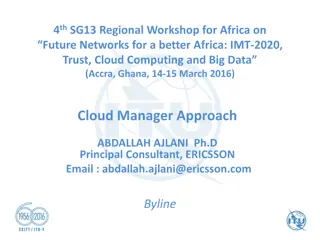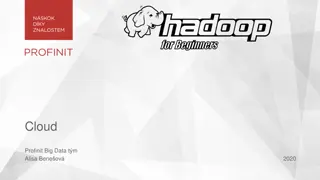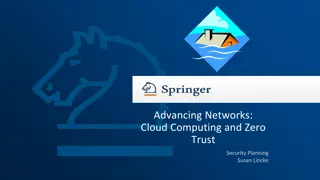
Cloud Computing Migration in National Weather Service - Insights & Recommendations
"Explore cloud computing migration concepts, challenges, and solutions in the context of the National Weather Service. Learn about infrastructure and platform as a service models, migration strategies, and key considerations for a successful transition to the cloud."
Download Presentation

Please find below an Image/Link to download the presentation.
The content on the website is provided AS IS for your information and personal use only. It may not be sold, licensed, or shared on other websites without obtaining consent from the author. If you encounter any issues during the download, it is possible that the publisher has removed the file from their server.
You are allowed to download the files provided on this website for personal or commercial use, subject to the condition that they are used lawfully. All files are the property of their respective owners.
The content on the website is provided AS IS for your information and personal use only. It may not be sold, licensed, or shared on other websites without obtaining consent from the author.
E N D
Presentation Transcript
N A T I O N A L O C E A N I C A N D A T M O S P H E R I C A D M I N I S T R A T I O N National Weather Service National Weather Service Cloud Computing Summary and Next Steps April 15, 2020
N A T I O N A L O C E A N I C A N D A T M O S P H E R I C A D M I N I S T R A T I O N Overview In late 2018, the Meteorological Development Lab in concert with Central Processing began to prototype cloud infrastructure for several NWS systems, and this forum will discuss some of what we ve learned thus far, and ideas for the future. 2
N A T I O N A L O C E A N I C A N D A T M O S P H E R I C A D M I N I S T R A T I O N Some basic cloud concepts Cloud computing is a general term describing a large ecosystem of different tools and concepts The major cloud providers are described as being Infrastructure as a Service (IaaS), meaning they provide computing resources as a service. Within each provider, there will be a mix of Platform as a Service (PaaS) and Software as a Service (SaaS). PaaS examples are databases, messaging, and compute. These provide the building blocks for SaaS, such as AWIPS and WES in the cloud. 3
N A T I O N A L O C E A N I C A N D A T M O S P H E R I C A D M I N I S T R A T I O N Migration Concepts Generally speaking, early efforts to migrate will often be to take an application and its dependencies, and move them to a virtual machine in the cloud. Later migrations will refactor an application to begin to take advantage of cloud tools, such as distributed databases and messaging. Advanced migrations will design the application as cloud-native, using the resources of the cloud platform. The closer to native you become, the more efficient, scalable, and cheaper the application becomes. 4
N A T I O N A L O C E A N I C A N D A T M O S P H E R I C A D M I N I S T R A T I O N Migration Questions to ask Do you have the technical knowledge to leverage cloud resources of your chosen provider? Does you application have dependencies on data, and if so, where is the data located? Do you need 24x7 support for your application? How much data will be served out (egress) by the application? How much data will need to be stored by the application? Have you done an analysis of your on-premises applications sizing needs? 5
N A T I O N A L O C E A N I C A N D A T M O S P H E R I C A D M I N I S T R A T I O N Migration Answers Get trained on the cloud provider you have chosen. Ensure your application data is close to the application. Plan a support model for where your application will run operationally. Know your data output, since this is a cost driver, as is storage and compute. On-premises applications tend to be over- provisioned, which will result in higher costs. Consider vendor lock-in as a factor 6
N A T I O N A L O C E A N I C A N D A T M O S P H E R I C A D M I N I S T R A T I O N What about security? FISMA requirements are no different for application in the cloud, and the same concepts apply. Within the public cloud, you will have virtual private clouds (VPCs), and within the VPCs you will have instances (ie. a specific application). Likewise, your FISMA boundary will extend around your VPCs and encompass your instances. There are specific best practices and tools for cloud security, but that s an entirely different talk. 7
N A T I O N A L O C E A N I C A N D A T M O S P H E R I C A D M I N I S T R A T I O N Accounts, groups, and users An account is the highest level and can be thought of as a container of users and instances. This can be used to consolidate billing. Groups exist within an account and define the roles and permissions of a group of users. Users are assigned to an individual or a service, inherit the roles and permissions of its groups, and provide for authenticated access. You may not even need to allow access to developers if you use a DevOps model. 8
N A T I O N A L O C E A N I C A N D A T M O S P H E R I C A D M I N I S T R A T I O N DevOps Currently, the NWS uses a waterfall approach to development, with requirements, coding, testing, then a release. Cloud computing will force us to rethink this, and move to a DevOps concept. In DevOps, releases are done frequently (up to several a day), but each change is small and specific. A Continuous Integration/Continuous Delivery (CI/CD) pipeline builds the application, runs the tests, and deploys the application automatically, each time the development team commits to a given repository. 9
N A T I O N A L O C E A N I C A N D A T M O S P H E R I C A D M I N I S T R A T I O N White Paper The success of the first projects showed tremendous potential for cloud computing within the NWS. These include AWIPS development, WES, and other development platforms. This led to the creation of a team to deeply research the best practices for cloud computing, and included representatives from throughout the agency. We reached out to other NOAA Line Offices, including NESDIS and NOS, who were farther along in standing up cloud resources. 10
N A T I O N A L O C E A N I C A N D A T M O S P H E R I C A D M I N I S T R A T I O N Key takeaways from the White Paper Preliminary - Under review by NWS Management All applications should be developed on or migrated to cloud environments, unless there is a specific circumstance which prevents doing so. All players need to be involved and engaged, including technical, security, networking, and finance. We have proposed a specialized Cloud Change Control Board with these skill sets to approve an application for cloud onboarding, and assist in doing so. These should be modeled after the CCCBs in other NOAA Line Officies. 11
N A T I O N A L O C E A N I C A N D A T M O S P H E R I C A D M I N I S T R A T I O N Key takeaways from the White Paper Preliminary - Under review by NWS Management This is a tremendous opportunity for our agency to modernize IT systems, while standardizing services and eliminating duplication. While security considerations are not necessarily any different in cloud environments, we recommend as many security aspects as possible be addressed up-front in pre-enabled environments in which personnel can more easily hit the ground running on their projects/learning. 12
N A T I O N A L O C E A N I C A N D A T M O S P H E R I C A D M I N I S T R A T I O N Key takeaways from the White Paper Preliminary - Under review by NWS Management Explore adopting newer DevOps paradigms (e.g. CI/CD) more common in the software industry, vs models traditionally used in the NWS. For the situation where development occurs in the cloud, but operations is on-premises, develop code/applications that are as portable and vendor- neutral as possible to ensure maximum flexibility, reproducibility across NOAA s multi-cloud environments 13
N A T I O N A L O C E A N I C A N D A T M O S P H E R I C A D M I N I S T R A T I O N Questions? Thank you to the NWS cloud computing white paper team: Jason Burks - CIRA/MDL Manan Dalal - NESDIS ACIO Office Matt Davis - OSTI/MDL Andrea Hardy - Office of Dissemination Scott Jacobs - Central Processing Paula Reis - NWS ACIO Office Jack Settelmaier - Southern Region Headquarters Ken Sperow - CIRA/MDL 14


